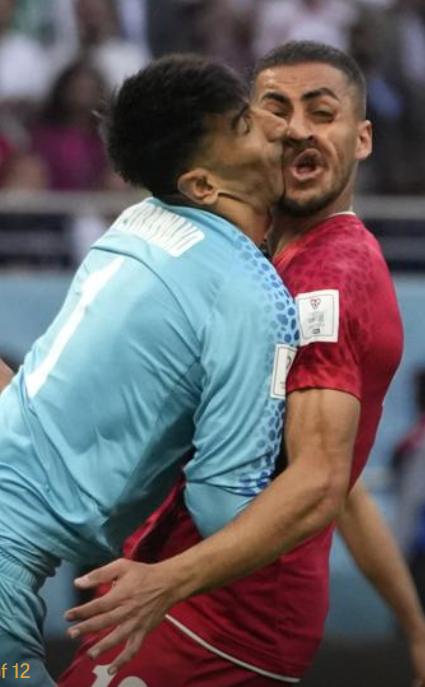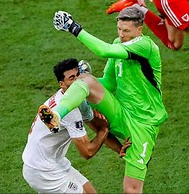October 14, 2022




In a nail-biting game, the United States defeated Iran 1-0 at the World Cup, once again stymying Team Melli’s dream of advancing beyond the initial group stage.
Iran only needed a tie against the United States, while the Americans had to have a win to advance. They got it.
The World Cup begins with a “group stage” in which the 32 teams are placed in groups of four that play each other, with the top two teams in each group advancing to the Group of 16. Iran has made it to the World Cup finals six times 1978, 1998, 2006, 2014, 2018 and 2022 but has never been able to advance from the group stage.
The American elimination of Iran this year was seen as something of a payback for 1998, when Iran defeated the US 2-1 and eliminated the Americans in the group stage.
Iran left the Cup ranked 26th of the 32 teams. It was the lowest ranked of the five Asian teams that won slots in the finals. Saudi Arabia was ranked 25th, just one slot above Iran. Both had the same 1-0-2 record and three points each, but the Saudis had a goal differential of -2 versus Iran’s -3. The other three Asian teams Japan, South Korea and Australia all advanced out of the group stage.
Iran’s record at this year’s cup was one win and two losses. In the first match, Iran was not just defeated but creamed 6-2 by England, an extremely embarrassing loss. The second game was scoreless at the end of regulation time, but Iran scored two goals in overtime to dramatically defeat Wales 2-0.
What distinguished both of those games was the losing team’s loss of their main goalkeeper. In the England match, Iran’s Ali-Reza Beiranvand was injured eight minutes into the game and had to be replaced by a backup. Beiranvand collided face-to-face with teammate Majid Hosseini as both men charged a ball dropping in front of the goal. All of England’s goals were scored against the backup, Hossein Hosseini.
In the match against Wales, the Welsh goalkeeper was issued a red card expelling him from the game for kicking an Iranian player in the 87th minute. While Wales could send in a replacement goalkeeper, the red card meant Wales had to play with just 10 men instead of 11 for the remainder of the game. Iran scored both of its goals against the shorthanded Welsh.
In the game against USA, the Americans dominated in the first half, with the ball spending most of its time in the Americans’ hands and threatening the Iranian goal and scoring in the 38th minute. That was reversed in the second half, so that time of possession was divided almost equally, 51 percent US and 49 percent Iran. But the US got five shots on goal while Iran got only a single one in the entire game and that one headed straight into the arms of the US goalkeeper.
In Iran’s 2-0 win over Wales, the two goals were scored three minutes apart in the last four minutes by Roozbeh Cheshmi, who plays professionally for Esteghlal of Tehran, and Ramin Rezaein, who plays for Sepahan of Tehran. Both men are defenders brought forward in the closing minutes in a desperate effort to score. The Welsh otherwise dominated the game, holding possession of the ball 62 percent of the game.
In the opener against England, the English were truly dominant, holding possession of the ball for 79 percent of the time and managing to score six times on seven shots on goal. Both of Iran’s goals were scored by Mehdi Taremi, one in the 65th minute, when Iran was already down 4-0 and the other near the end of injury overtime on a penalty kick.
Iran was just not the same after goalkeeper Beiranvand was injured. Coach Queiroz was heavily criticized for trying to keep him in the game. But 10 minutes later, Beiranvand slumped to the ground and had to be removed on a stretcher.
Iran’s record over the six cups in which it has appeared is three wins (over the US in 1998, over Morocco four years ago and over Wales this year), four draws and 11 losses, having scored 12 goals and given up a whopping 31.
Iran went into the Cup finals rated the strongest team in Asia by the computer ranking system used by FIFA, the governing body of international soccer. As such, fans now pretty much expect it to qualify for the finals every four years. The goal is therefore to emerge from the group stage and that continues to elude Team Melli.
Iran easily qualified for the finals this year with 14 wins, one draw and three losses in 18 qualifying matches played over the last two years.
But Iran coach Carlos Queiroz, a Portuguese national, became ever more concerned about Iran’s chances as his preparations for the World Cup hit one problem after another. For example, two key defensive players were still playing for their Qatar professional club, which refused to release them with the first Cup game just three weeks away.
Earlier, it was announced that star striker Sardar Azmoun had torn a muscle in his right calf while practicing with his professional club, Bayer Leverkusen of Germany, and likely would miss the World Cup. (See last issue of Iran Times, page three.) But Azmoun recovered in time for the Cup although he did not score.
“In one way or another, the reality is that our preparation program is not moving in the right direction,” Queiroz said to reporters at the national team training camp October 31.
“Preparation is a key step in our way to the 2022 World Cup. Without preparation, it is difficult to succeed. When the players are not here to be part of the team selection, it’s difficult to consider them. So, probably, some of them lose their position in the national team because they are not here,” he said.
“For instance, we have a problem with our two important players, Shoja Khalilzadeh and Hossein Kananizadegan. Unfortunately, Qatari club Al Ahli do not allow them to train with us. But five weeks without playing football before a big tournament like the World Cup makes it difficult for them to be part of the list; it’s very difficult,” Queiroz said. Both made the squad in the end.
“The only players in Qatar soccer who have not been released are the Iranian players from Al Ahli. All the other players, including Australians, Algerians and Tunisians, were released for their national teams, but Al Ahli did not allow them to come here.”
In almost an aside, the Tehran Times quoted Queiroz as saying, “Esteghlal’s players are not here also. So, I just can say that our preparation process could be better.” Queiroz had called up three Esteghlal players, a goalkeeper and two defenders. With four defenders not in attendance, the team was deep in a hole. (All three Esteghlal players made the team in the end.)
The team managed to schedule only two fall friendly matches, against Nicaragua November 10 in Tehran and Tunisia November 16 in Qatar. The match against Nicaragua was played without Iran’s players who play for foreign teams, the Tehran Times reported, which reduced the usefulness of the game. But Iran, ranked 20th in the world, easily prevailed over Nicaragua, ranked 142nd, by a score of 1-0. The ball was in the Nicaraguan half most of the game and Iranian goalkeeper Alireza Beiranvand spent most of the game as a spectator.
As for the friendly against Tunisia (also a World Cup finalist ranked 30th in the world), Iran lost 2-0. But Queiroz was happy because it was the first time he had all his players available. At Iran’s insistence, both matches were played in empty stadiums so fans could not make political demonstrations.
Earlier in the year, Iran played friendlies against Uruguay and Senegal.
Russia announced a few months back that it would play Iran in a friendly November 16, a week before the start of the World Cup. But the Tehran Times reports that Coach Queiroz scotched that plan, presumably because he saw it as a political move that would taint the Iranian team in the eyes of Europeans.
FIFA fought off demands from many around the world to kick Iran out of the World Cup for its repression of protesters. Queiroz likely did not wish to give the critics more ammunition. Russia has already been kicked out of the Cup for its invasion of Ukraine.
As for the team uniforms, unlike in 2014 and 2018, they did not carry pictures of the cheetah accompanied by an endorsement of efforts to save the cheetah from extinction. The campaign to rescue the cheetah earlier this year acknowledged failure, saying only about a dozen cheetahs survive in the wild.
